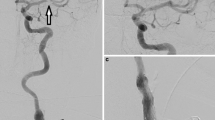Abstract
Introduction
We evaluated the feasibility of employing a self-expanding stent (Neuroform) in treatment of acute cerebral ischemia and compared the results of primary and secondary stenting.
Methods
We analyzed the treatment results of 14 acute ischemic stroke patients (11 men and three women; median age, 65 years) who were treated with Neuroform stents. Seven patients received stent placement for primary recanalization and a further seven for secondary recanalization. We performed between-group comparisons of all of overall procedure duration, recanalization rate immediately after stenting, need for additional measures after stenting, final recanalization rate, occurrence of hemorrhagic transformation, early re-occlusion rate after 24 h, and 3-month functional recovery rate (mRS ≤2).
Results
The median interval from femoral puncture to stent placement was 61.5 min and was significantly shorter in the primary than in the secondary group (55 vs. 95 min, p = 0.004). The recanalization rate immediately after stenting was 42.9% and was greater in the primary than in the secondary group (71.4% vs. 14.3%, p = 0.1). Thirteen patients required various additional therapeutic measures. The final recanalization rate was 78.6%, attributable to improvements in the recanalization rate of the secondary group (71.4% vs. 85.7%). Early hemorrhagic transformation was noted in four patients, but only one patient became symptomatic (symptomatic hemorrhage, 7.1%). Good functional recovery was noted in eight patients (57.1%).
Conclusion
Placement of a self-expanding stent during endovascular recanalization of acute ischemic stroke was both feasible and safe. Primary use of this method may enhance early recanalization.




Similar content being viewed by others
References
Nogueira RG, Yoo AJ, Buonanno FS, Hirsch JA (2009) Endovascular approaches to acute stroke, part 2: a comprehensive review of studies and trials. AJNR Am J Neuroradiol 30:859–875
Nogueira RG, Schwamm LH, Hirsch JA (2009) Endovascular approaches to acute stroke, part 1: drugs, devices, and data. AJNR Am J Neuroradiol 30:649–661
Mori T, Kazita K, Seike M, Nojima Y, Mori K (1999) Successful cerebral artery stent placement for total occlusion of the vertebrobasilar artery in a patient suffering from acute stroke. J Neurosurg 90:955–958
Gupta R, Schumacher HC, Mangla S et al (2003) Urgent endovascular revascularization for symptomatic intracranial atherosclerotic stenosis. Neurology 61:1729–1735
Lin DD, Gailloud P, Beauchamp NJ, Aldrich EM, Wityk RJ, Murphy KJ (2003) Combined stent placement and thrombolysis in acute vertebrobasilar ischemic stroke. AJNR Am J Neuroradiol 24:1827–1833
Levy EI, Siddiqui AH, Crumlish A et al (2009) First food and drug administration-approved prospective trial of primary intracranial stenting for acute stroke. SARIS (Stent-Assisted Recanalization in Acute Ischemic Stroke). Stroke 40:3552–3556
Brekenfeld C, Schroth G, Mattle HP et al (2009) Stent placement in acute cerebral artery occlusion: use of a self-expandable intracranial stent for acute stroke treatment. Stroke 40:847–852
Zaidat OO, Wolfe T, Hussain SI et al (2008) Interventional acute ischemic stroke therapy with intracranial self-expanding stent. Stroke 39:2392–2395
Levy EI, Mehta R, Gupta R et al (2007) Self-expanding stents for recanalization of acute cerebrovascular occlusions. AJNR Am J Neuroradiol 28:816–822
Sauvageau E, Levy EI (2006) Self-expanding stent-assisted middle cerebral artery recanalization: technical note. Neuroradiology 48:405–408
Suh SH, Kim BM, Roh HG et al (2010) Self-expanding stent for recanalization of acute embolic or dissecting intracranial artery occlusion. AJNR Am J Neuroradiol 31:459–463
Cho AH, Sohn SI, Han MK et al (2008) Safety and efficacy of MRI-based thrombolysis in unclear-onset stroke. A preliminary report. Cerebrovasc Dis 25:572–579
Levy EI, Ecker RD, Horowitz MB et al (2006) Stent-assisted intracranial recanalization for acute stroke: early results. Neurosurgery 58:458–463, discussion 463
Mocco J, Snyder KV, Albuquerque FC et al (2009) Treatment of intracranial aneurysms with the Enterprise stent: a multicenter registry. J Neurosurg 110:35–39
Castano C, Serena J, Davalos A (2009) Use of the new solitaire (TM) AB device for mechanical thrombectomy when merci clot retriever has failed to remove the clot. Interv Neuroradiol 15:209–214
Hauck EF, Mocco J, Snyder KV, Levy EI (2009) Temporary endovascular bypass: a novel treatment for acute stroke. AJNR Am J Neuroradiol 30:1532–1533
Kelly ME, Furlan AJ, Fiorella D (2008) Recanalization of an acute middle cerebral artery occlusion using a self-expanding, reconstrainable, intracranial microstent as a temporary endovascular bypass. Stroke 39:1770–1773
Acknowledgements
This study was supported by a grant (2009–329) from the Asan Institute for Life Science, Seoul, Korea.
Conflict of Interest
We declare that we have no conflict of interest.
Author information
Authors and Affiliations
Corresponding author
Rights and permissions
About this article
Cite this article
Kim, S.M., Lee, D.H., Kwon, S.U. et al. Treatment of acute ischemic stroke: feasibility of primary or secondary use of a self-expanding stent (Neuroform) during local intra-arterial thrombolysis. Neuroradiology 54, 35–41 (2012). https://doi.org/10.1007/s00234-010-0813-3
Received:
Accepted:
Published:
Issue Date:
DOI: https://doi.org/10.1007/s00234-010-0813-3




